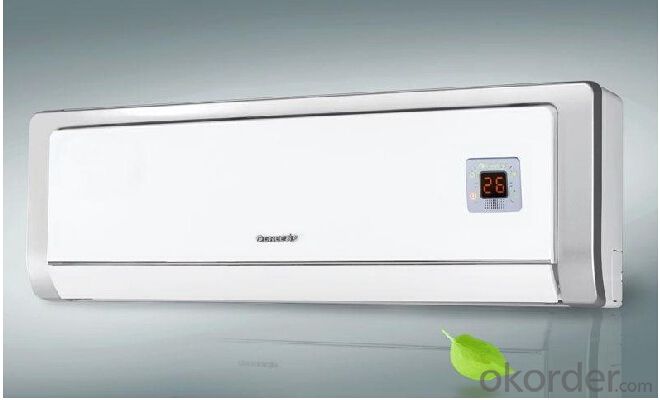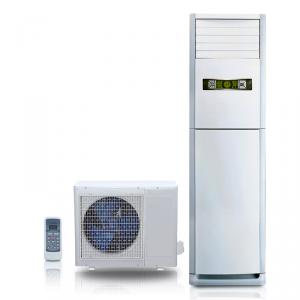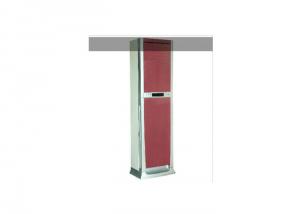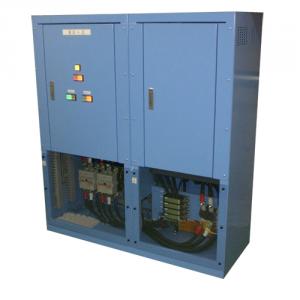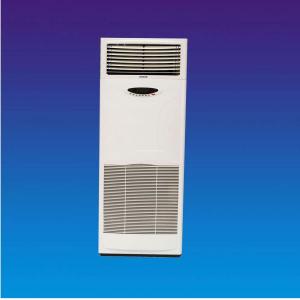Wall Mounted Split Air Conditioner 30000BTU CS-12H/AZ3-5
- Loading Port:
- Shanghai
- Payment Terms:
- TT OR LC
- Min Order Qty:
- 1 unit
- Supply Capability:
- 30 unit/month
OKorder Service Pledge
OKorder Financial Service
You Might Also Like
Quick Details
| Condition: | New | Brand Name: | CNBM | Place of Origin: | Jiangsu China (Mainland) |
| Use: | Room | Power Source: | Electrical | Power Type: | AC |
| Type: | Split Wall Mounted Air Conditioners | Cooling/Heating: | Cooling/Heating | Certification: | CB,CE,EMC,RoHS |
| Capacity (btu): | 12000 | COP: | 2.8 | EER: | 2.8 |
| Power (W): | 1200 | Voltage (V): | 220 | Model Number: | CS-12H/AZ3-5 |
| Condenser: | Pure Copper | Connecting Pipe: | Pure Copper | Cable: | 3m |
| Compressor type: | Rotary | Loading Quantity: | 150sets (40HQ) | Application Area: | 60m3 |
Packaging & Delivery
| Packaging Detail: | Carton Box Packing |
| Delivery Detail: | 30-45 days after receiving down payment |
Specifications
Wall mounted air conditioner :
1, R22/R410a
2, 30000BTU ;
3, Cooling only/Cooling& Heating ;
4, 220V 50HZ/60Hz.
Wall Mounted Split Air Conditioner 12000BTU
1) Reliable quality---professional assembling and sufficient test, defective rate below 0.05%.
2) High quality compressors and parts with guarantee;.
3) Delivery: Within 45days after confirming the L/C or T/T swift copy.
4) Certificate--- CE, RHOS,MEPS, SAA, C-TICK, EMC, BV, SGS, ISO9001,SAA,CB, etc..
5) Compressor Brand: CHUNLAN, TOSHIBA, RCHI
6) 1% free parts of the total FOB amount.
7)OEM service.
- Q: A little big, about 20 square meters, western is better in the afternoon, also a refrigerator in the room The air conditioning can be used to buy a few horses please? How much can effect comparing And could you tell me the general case, low energy consumption is larger than that of high energy consumption of air conditioning how much point (in one hour)
- The level of energy efficiency of air conditioning and can effect comparing The level of energy efficiency of air conditioning, is marked with "China's energy efficiency label". "China's energy efficiency label" is a concept of market access, it visually express the electrical appliances product energy efficiency level. Level 1 is the most energy saving; The energy saving efficiency of the 2 ~ 4 drops; 5 levels of lowest energy saving is the threshold level of the product into the market.
- Q: The residential air conditioning machine within the power supply and power supply?
- The first indoor parts are usually made of 220 v electric power supply to the transformer - control main board - seg. Actually, the power supply is controlled by the indoor machine of outdoor mainboard control 220 v power on and off. There are a few models is the direct outdoor on 220 v power supply controlled by the indoor machine control main board 12 v or 24 v direct current control of the ac contactor to outdoor open or stop the outdoor but now the mainstream models are adopted.
- Q: Home air conditioning is good and fission central air conditioning air conditioning is good
- Install the central air conditioning is good - home central air-conditioning compared with fission machine initial investment With 120 ㎡ 3 rooms two hall bedroom to estimate, the loading of ordinary probably need 4 air conditioner: household air conditioning respectively is 1 3 ark, sitting room advocate the bedroom 1 1.5 hang machine, two small bedroom installation 1 small one hang, if with daikin frequency conversion air conditioning, total about 22000 yuan to 22000 yuan; And installation of household central air conditioning is about the initial investment of 30000 yuan, and the cost of average household fission energy saving model
- Q: What is the working principle of air conditioning?
- The general is using refrigerant refrigeration and air conditioning. Is first of all, the gaseous refrigerant compressor compression for liquid, in the process, the refrigerant is compressed into a liquid, the coolant temperature rises, the temperature of the purpose is to improve the temperature difference between refrigerant and the environment, and then coolant temperature higher than the environment temperature and the heat release from the outside environment, the temperature drop to normal temperature, the pressure of the gas in the process of heat transfer that is constant, and then let the normal temperature of the liquid refrigerant entering the indoor evaporator, let cool liquid refrigerant expansion, make the temperature lower than indoor temperature so that the indoor air to the refrigerant exothermic, refrigerant heat recovery to normal temperature gas entering the compressor compressed again, continuous refrigeration cycle.
- Q: What is the difference between ordinary air conditioning and central air conditioning
- Household central air conditioner, or household central air conditioning, no type adjustable central air-conditioning) is produced by an outdoor cold (hot) source and then to the various rooms and cooling air conditioning (hot), it is to belong to a (small) commercial air conditioning. Household central air conditioning is divided into two wind system and water system. The wind system of outdoor, indoor host, supply air pipe and each room and regulating valves, etc; Water system consists of separate-bodied air-conditioners, water pipes, circulating pump, and at the end of the indoor coil (wind machine, surface mounted, etc.). The characteristics of the household central air conditioning is: 1 under the condition of the whole family is in comfort, avoid direct blowing cold and other fission machine room cold hot uneven body unwell phenomenon; 2 good decorative, cooperate to decorate no pipe leakage; 3 simple operation, automatic operation, no maintenance; 4 according to the orientation, function of each room to increase or decrease supply air (hot); 5 can add fresh air and add wet, keep indoor air fresh and health. The limitations of household central air conditioning is: 1 decorate on, design and installation to combine with decorate can achieve good comfort and decorative effect; 2 power requirement: electric load is bigger. If the old housing to consider circuit load enough.
- Q: There are the condenser and throttling device is then? Household air throttle device is thermodynamic expansion valve?
- Evaporator in the indoor machine. Compressor, condenser, throttle device outside the machine. Ordinary household air throttle device using capillary without thermal expansion valve.
- Q: Electric power is generally how many watts family air conditioning?
- Air conditioning general nominal horse, horse machine input power is 735 w, 1 2 horse machine input power 1500 w. Ark the input power generally is greater than 2000 w, can check the product nameplate, the choose and buy has a rated power input, is mainly used in household electric power calculation. See the model of air conditioner and can effect comparing, can know air conditioner work of electric power consumption.
- Q: Use battery can drive the air conditioning, can want to much
- Home air conditioning is ac power source, unless the battery dc inverter after use Car air conditioning is mechanical drive, you want to use dc motor driver to use the battery power supply
- Q: Air conditioning machine which is high pressure pipe? Which is of low pressure pipe?
- Cooling tube for high pressure, tubes for low pressure pipe. The working principle of air conditioning: compressor, condenser, throttle valve, evaporator, Reduce the compressor refrigeration: the high temperature and high pressure gas entering the condenser, in the outdoor condenser absorbs heat to high pressure liquid at room temperature, and then enter the throttle valve after decompression low pressure low temperature of liquid, entered the room after the evaporator absorbs the heat of the room into a low pressure gas at room temperature, then in the compressor, the cycle of the cycle. Heating: high-temperature high-pressure gas from compressor discharge directly into the room of the condenser heat absorption cooling in the room into a high-pressure liquid at room temperature, and then enter the throttle valve, the step-down into low pressure low temperature liquid, then after the evaporator absorbs heat into outdoor outdoor low temperature gas in the compressor, the cycle of the cycle. Actually is evaporator condenser, condenser and evaporator, they're just different in cooling and heating function known as condenser or evaporation. Air conditioner: when heating by the compressor, four-way valve, valve, outdoor heat exchanger of indoor machine, cooling pipe, valve, capillary, condenser, electromagnetic four-way valve, receiver, condenser, compressor.
- Q: Outside air conditioning machine how to cleaning?
- Air conditioning separate-bodied air-conditioners design considering the outdoor environmental factors, need not wash, the sun wind rain naturally clean, will not affect the use.
Send your message to us
Wall Mounted Split Air Conditioner 30000BTU CS-12H/AZ3-5
- Loading Port:
- Shanghai
- Payment Terms:
- TT OR LC
- Min Order Qty:
- 1 unit
- Supply Capability:
- 30 unit/month
OKorder Service Pledge
OKorder Financial Service
Similar products
Hot products
Hot Searches
Related keywords

